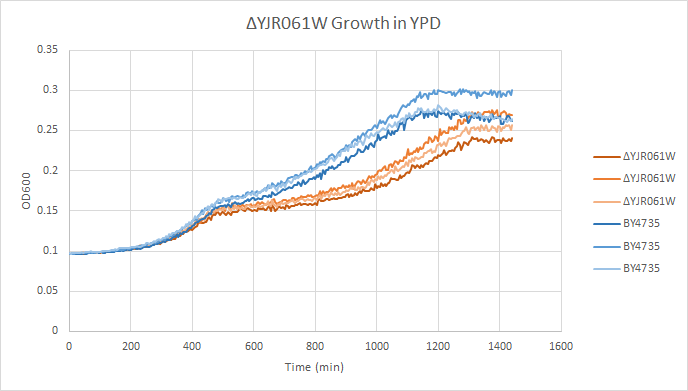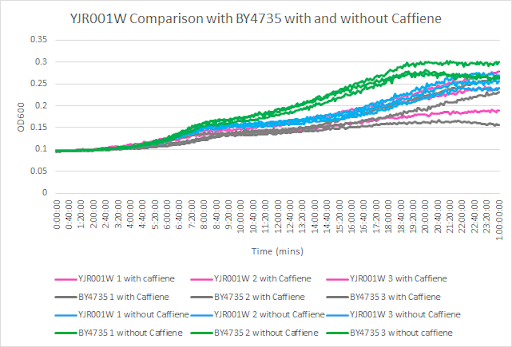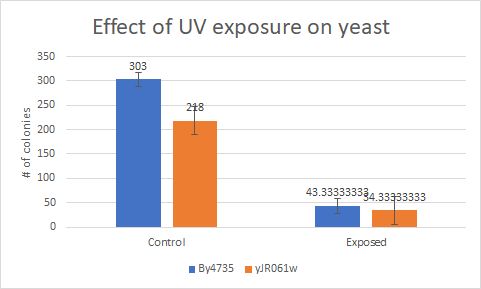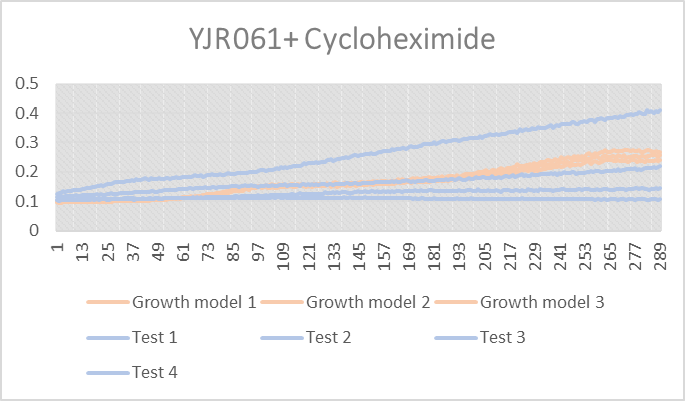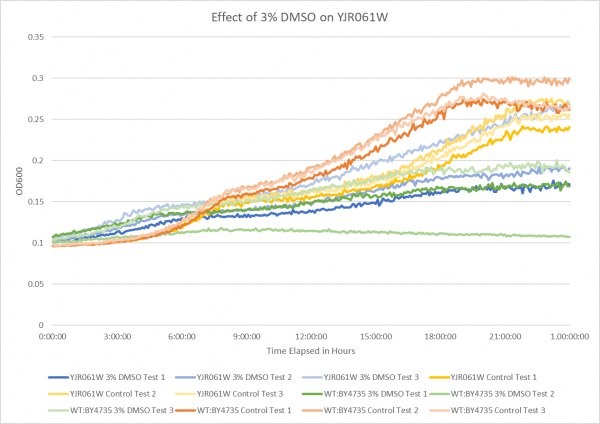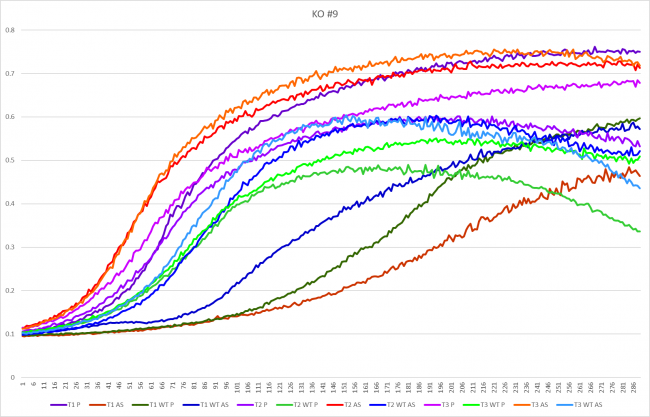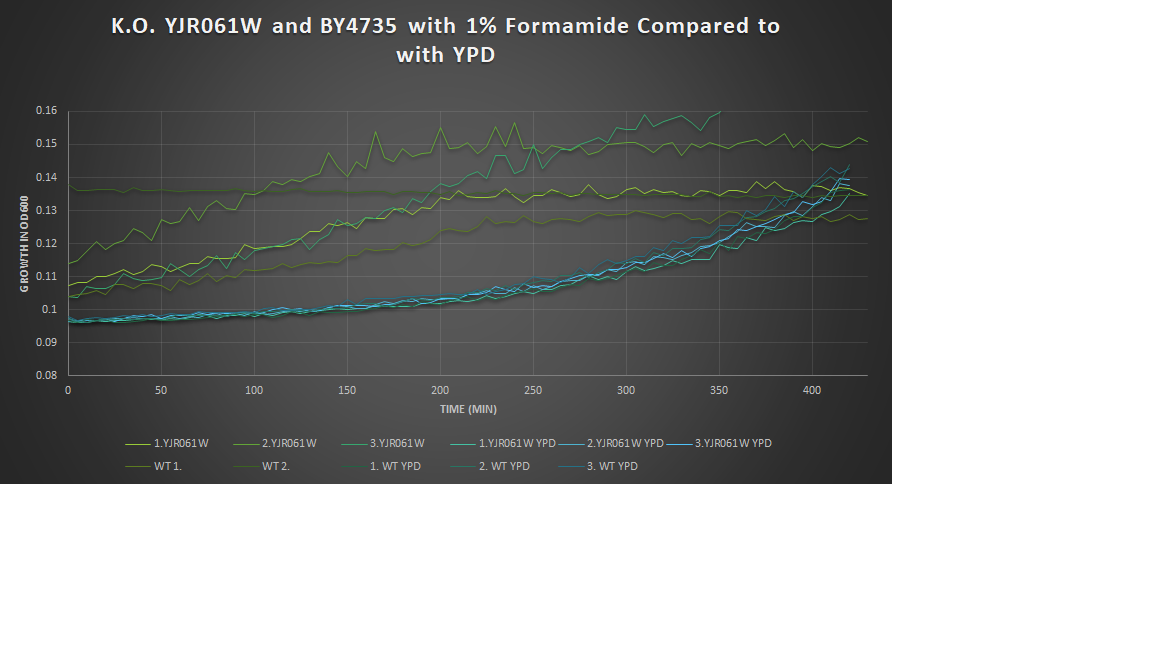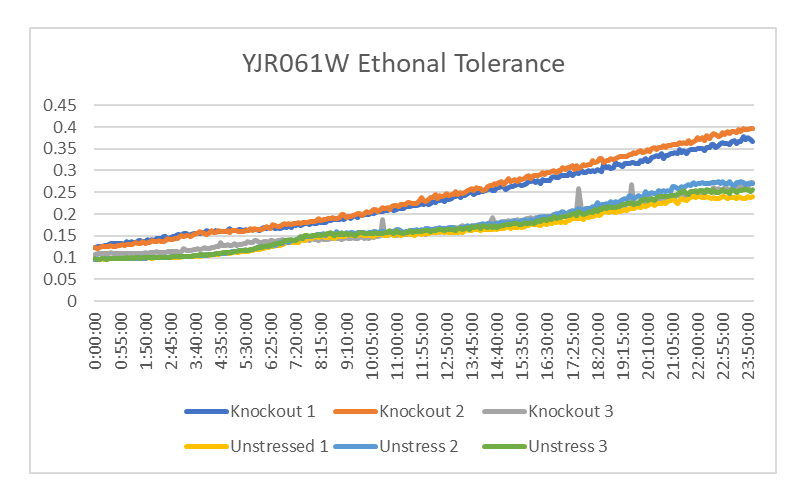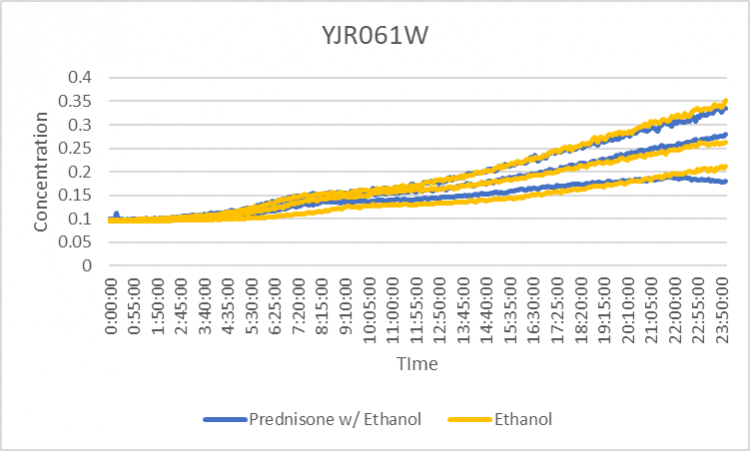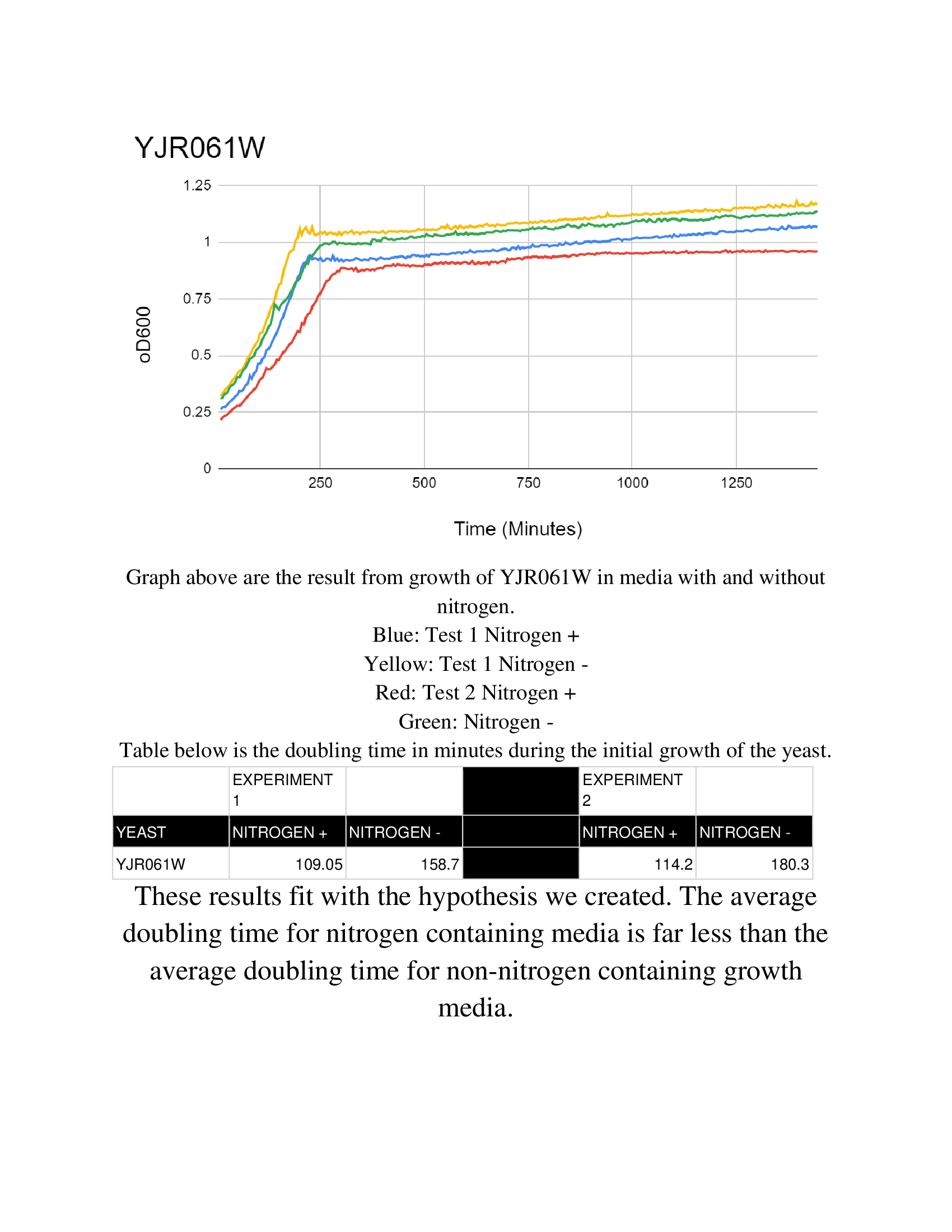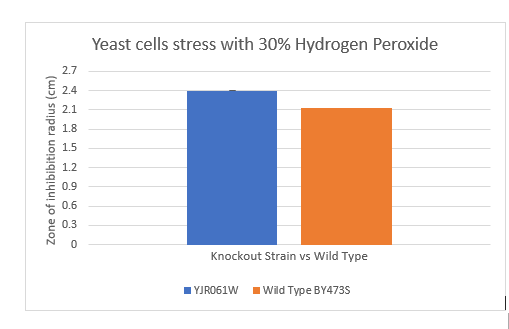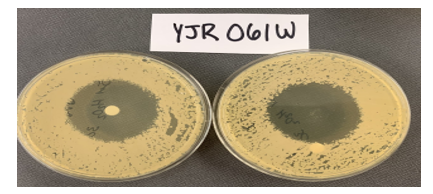Difference between revisions of "YJR061W"
(→Community Commentary) |
(→Zone of Inhibition of 30% Hydrogen Peroxide on YJR061W) |
||
| (18 intermediate revisions by the same user not shown) | |||
| Line 63: | Line 63: | ||
As you can see in the figure above test 4 was thriving and doing well. Tests 1, 2, & 3 were below the growth curve. Growth models 1-3 are The yeast strand YJR061 without any stress. | As you can see in the figure above test 4 was thriving and doing well. Tests 1, 2, & 3 were below the growth curve. Growth models 1-3 are The yeast strand YJR061 without any stress. | ||
| + | |||
| + | |||
| + | ===Effect of 3% [[UW Stout/DMSO FA19|DMSO]] on YJR061W=== | ||
| + | |||
| + | [[Image:Effect_of_3%_DMSO_on_YJR061W.png|600px]] | ||
| + | |||
| + | The graph above shows the effect of 3% DMSO on YJR061W. From the data represented the average doubling rate for the YJR061W knockout strain without DMSO was 591 minutes. When DMSO is added the average doubling time increased to 1331 minutes. This shows that 3% DMSO did add stress to this knockout strain. The average doubling time of WT:BY4735 without DMSO was 514 minutes. The average doubling rate for WT:BY4735 with DMSO was 1529 minutes. If we compare the average doubling rate of WT:BY4735 with DMSO to YJR061W with DMSO we can see that without the YJR061W gene the yeast was able to grow more quickly under DMSO induced stress. It is also observed that both control groups had a very close growth rate, which means that the YJR061W gene has a minimal effect of yeast growth in optimal conditions. | ||
| + | |||
| + | |||
| + | ===[[UW Stout/Proline FA19|Growth in Proline and Ammonium Sulfate]]=== | ||
| + | |||
| + | [[File:KO9.png|650 px]] | ||
| + | |||
| + | |||
| + | For the YJR061W strand, it grew faster in the proline media with a average doubling time of 36.53 minutes. It grew with an average doubling time of 45.67 minutes in ammonium sulfate media. The wild types were peculiar in these tests because they had the exact same average doubling time of 44.73 minutes. | ||
| + | |||
| + | ===1% Formamide Yeast Torture[[https://wiki.yeastgenome.org/index.php/UW_Stout/Formamide_FA19]]=== | ||
| + | |||
| + | [[Image:ko9.png]] | ||
| + | |||
| + | This graph shows the growth curve of the knockout yeast strain YJR061W and wild type BY4735 in 1% formamide in 3 trials. The average calculated doubling time for YJR061W with 1% formamide was 2,098.56 minutes, while the unstressed strain was 2,966.34 minutes. This concluded that the stressed out strain is not sensitive to 1% formamide, and grows at a faster pace in this environment. Our stressed wild types doubling time was 2,865.52 minutes, and the unstressed was 2,468.04 minutes. Proving that the addition of 1% formamide makes the stressed strain more sensitive to it's surroundings and leads to slower growth. | ||
==Ethanol Tolerance in YJR061W== | ==Ethanol Tolerance in YJR061W== | ||
[[Image:YJR061W_ethonal.png]] | [[Image:YJR061W_ethonal.png]] | ||
| − | This graph shows the growth between YJR061W treated and untreated with ethanol. The yeast treated with ethanol had a growth rate of | + | This graph shows the growth between YJR061W treated and untreated with ethanol. The yeast treated with ethanol had a growth rate of 1418.74 minutes. The yeast not treated with ethanol had a growth rate of 1822.83. This shows that the strands of YJR061W treated with ethanol had a decrease growth rate compared to those who weren't. |
===[[UW-Stout/Prednisone_FA19|Prednisone Effects on YJR061W]]=== | ===[[UW-Stout/Prednisone_FA19|Prednisone Effects on YJR061W]]=== | ||
[[File:YJR061W.png|750 px]] | [[File:YJR061W.png|750 px]] | ||
| + | |||
| + | The graph above shows how dilutions P2 (30 µg/ml) and E2 (10% ethanol solution) impacted the growth rate of the knockout yeast strain YJR061W over 24 hours. The concentration did not double for test 3 of P2 for this experiment, so by taking only the first two test results, the doubling rate averages to around 907.5 minutes for only ethanol. As for the Prednisone with ethanol, the doubling rate averages to around 907.5 minutes. The Prednisone with ethanol typically has the same growth rate as the ethanol alone for this strain. | ||
| + | |||
| + | [[File:Nitrogen_Starvation_YJR061W.jpg|463 x 599|Caption]] | ||
| + | |||
| + | The Wild Type BY4735 has data located at the Nitrogen Starvation Protocol. | ||
| + | ==[[UW-Stout/Nitrogen_starvation_FA19|Nitrogen starvation]]== | ||
| + | |||
| + | == [https://wiki.yeastgenome.org/index.php?title=UW-Stout/Hydroxyurea_FA19&oldid=401696 Hydroxyurea] == | ||
| + | [[File:AvaYJR061W.png]] | ||
| + | The averaging doubling time for YJR061W is 181.99 minutes. The averaging doubling time for the unstressed YJR061W is 437.11 minutes | ||
<!-- PLEASE ADD Community Commentary ABOVE THIS MESSAGE. See below for an example of community annotation --> | <!-- PLEASE ADD Community Commentary ABOVE THIS MESSAGE. See below for an example of community annotation --> | ||
| Line 79: | Line 111: | ||
--> | --> | ||
| + | ===Zone of Inhibition of 30% [https://wiki.yeastgenome.org/index.php/UW-Stout/Hydrogen_peroxide_FA19 Hydrogen Peroxide] on YJR061W=== | ||
| + | [[File:JJ9.PNG]] | ||
| + | [[File:JaredJ9.PNG]] | ||
| − | + | The bar graph represents the zone of inhibition of the knockout strain versus the wild type. Our data collected shows that the knockout strain saw a larger zone of inhibition (cells were not able to grow there). Using these observations it is evident that the yeast strain YJR061W undergoes more stress from the oxidative properties of 30 percent hydrogen peroxide. The zone of inhibition is larger because the yeast cells are not able to grow as well as the wild type can in these conditions. For the strain YJR061W our plate values were as follows (in cm) 2.4, 2.4 compared to our wild type plate which stayed constant 2.1, 2.1 and 2.2 cm | |
| + | *Note our third plate saw negative results as the disc which contained hydrogen peroxide adjusted its placing and we could not get a good reading for the zone of inhibition which is why we did this experiment three times. Two averages will make us deviate further from the mean. | ||
<protect> | <protect> | ||
Latest revision as of 09:37, 18 December 2019
Share your knowledge...Edit this entry! <protect>
| Systematic name | YJR061W |
| Gene name | |
| Aliases | |
| Feature type | ORF, Uncharacterized |
| Coordinates | Chr X:550511..553318 |
| Primary SGDID | S000003822 |
Description of YJR061W: Putative protein of unknown function; non-essential gene with similarity to Mnn4, a putative membrane protein involved in glycosylation; transcription repressed by Rm101p[1][2]
</protect>
Contents
Community Commentary
About Community Commentary. Please share your knowledge!
This gene is part of the UW-Stout Orphan Gene Project. Learn more here.
Growth in YPD
In a BY4735 background, knocking out YJR061W seems to have little to no effect on growth rate in log-phase. In this assay, the BY4735 strain's doubling time was 414 minutes, while the YJR061W knock-out strain's doubling time was 436 minutes. (These doubling times are the means of three experiments.)
Caffeine and Yeast Cells
This graph shows the growth curve with and without caffeine. It has the knockout strain and wild type yeast cells. The caffeine enhanced the growth in both wild type and knockout strain. The average doubling time between the three experiments for the knockout strand was 824.60 minutes. The caffeine also had a positive effect on the growth curve for the wild type with the average doubling time being 1245.02 minutes. The results were concluded from the wild type and knockout strand was with this amount of caffeine it leads to an increase in growth.
- Note: The graph should be labeled YJK061W
The protocol can be found at
Caffeine
This bar graph showsthat compared to a BY4735 background, Knocking out yJR061w makes yeast a little bit more sensitive to UV light.
The protocol can be found at
UV Light Exposure
Cycloheximide effecting YJR061W
As you can see in the figure above test 4 was thriving and doing well. Tests 1, 2, & 3 were below the growth curve. Growth models 1-3 are The yeast strand YJR061 without any stress.
Effect of 3% DMSO on YJR061W
The graph above shows the effect of 3% DMSO on YJR061W. From the data represented the average doubling rate for the YJR061W knockout strain without DMSO was 591 minutes. When DMSO is added the average doubling time increased to 1331 minutes. This shows that 3% DMSO did add stress to this knockout strain. The average doubling time of WT:BY4735 without DMSO was 514 minutes. The average doubling rate for WT:BY4735 with DMSO was 1529 minutes. If we compare the average doubling rate of WT:BY4735 with DMSO to YJR061W with DMSO we can see that without the YJR061W gene the yeast was able to grow more quickly under DMSO induced stress. It is also observed that both control groups had a very close growth rate, which means that the YJR061W gene has a minimal effect of yeast growth in optimal conditions.
Growth in Proline and Ammonium Sulfate
For the YJR061W strand, it grew faster in the proline media with a average doubling time of 36.53 minutes. It grew with an average doubling time of 45.67 minutes in ammonium sulfate media. The wild types were peculiar in these tests because they had the exact same average doubling time of 44.73 minutes.
1% Formamide Yeast Torture[[1]]
This graph shows the growth curve of the knockout yeast strain YJR061W and wild type BY4735 in 1% formamide in 3 trials. The average calculated doubling time for YJR061W with 1% formamide was 2,098.56 minutes, while the unstressed strain was 2,966.34 minutes. This concluded that the stressed out strain is not sensitive to 1% formamide, and grows at a faster pace in this environment. Our stressed wild types doubling time was 2,865.52 minutes, and the unstressed was 2,468.04 minutes. Proving that the addition of 1% formamide makes the stressed strain more sensitive to it's surroundings and leads to slower growth.
Ethanol Tolerance in YJR061W
This graph shows the growth between YJR061W treated and untreated with ethanol. The yeast treated with ethanol had a growth rate of 1418.74 minutes. The yeast not treated with ethanol had a growth rate of 1822.83. This shows that the strands of YJR061W treated with ethanol had a decrease growth rate compared to those who weren't.
Prednisone Effects on YJR061W
The graph above shows how dilutions P2 (30 µg/ml) and E2 (10% ethanol solution) impacted the growth rate of the knockout yeast strain YJR061W over 24 hours. The concentration did not double for test 3 of P2 for this experiment, so by taking only the first two test results, the doubling rate averages to around 907.5 minutes for only ethanol. As for the Prednisone with ethanol, the doubling rate averages to around 907.5 minutes. The Prednisone with ethanol typically has the same growth rate as the ethanol alone for this strain.
The Wild Type BY4735 has data located at the Nitrogen Starvation Protocol.
Nitrogen starvation
Hydroxyurea
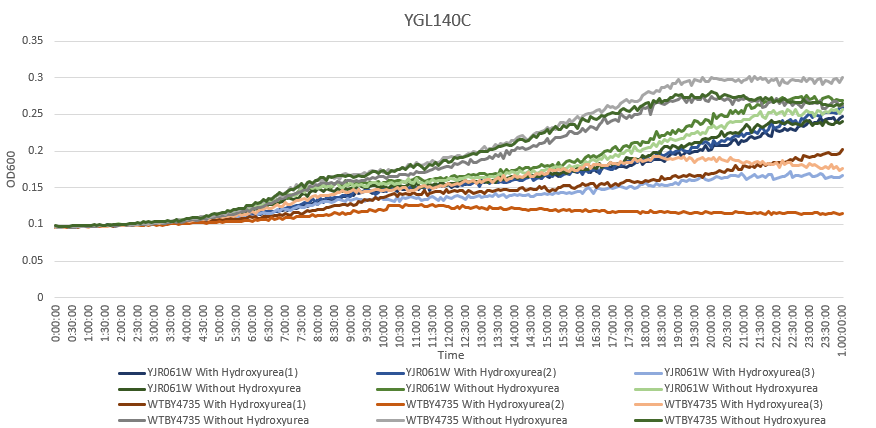 The averaging doubling time for YJR061W is 181.99 minutes. The averaging doubling time for the unstressed YJR061W is 437.11 minutes
The averaging doubling time for YJR061W is 181.99 minutes. The averaging doubling time for the unstressed YJR061W is 437.11 minutes
Zone of Inhibition of 30% Hydrogen Peroxide on YJR061W
The bar graph represents the zone of inhibition of the knockout strain versus the wild type. Our data collected shows that the knockout strain saw a larger zone of inhibition (cells were not able to grow there). Using these observations it is evident that the yeast strain YJR061W undergoes more stress from the oxidative properties of 30 percent hydrogen peroxide. The zone of inhibition is larger because the yeast cells are not able to grow as well as the wild type can in these conditions. For the strain YJR061W our plate values were as follows (in cm) 2.4, 2.4 compared to our wild type plate which stayed constant 2.1, 2.1 and 2.2 cm
- Note our third plate saw negative results as the disc which contained hydrogen peroxide adjusted its placing and we could not get a good reading for the zone of inhibition which is why we did this experiment three times. Two averages will make us deviate further from the mean.
<protect>
References
See Help:References on how to add references
- ↑ Conde R, et al. (2003) Screening for new yeast mutants affected in mannosylphosphorylation of cell wall mannoproteins. Yeast 20(14):1189-211 SGD PMID 14587103
- ↑ Lamb TM and Mitchell AP (2003) The transcription factor Rim101p governs ion tolerance and cell differentiation by direct repression of the regulatory genes NRG1 and SMP1 in Saccharomyces cerevisiae. Mol Cell Biol 23(2):677-86 SGD PMID 12509465
See Help:Categories on how to add the wiki page for this gene to a Category </protect>
